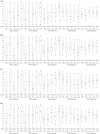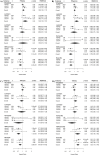Basal-like breast cancer with low TGFβ and high TNFα pathway activity is rich in activated memory CD4 T cells and has a good prognosis
- PMID: 33767579
- PMCID: PMC7975701
- DOI: 10.7150/ijbs.56128
Basal-like breast cancer with low TGFβ and high TNFα pathway activity is rich in activated memory CD4 T cells and has a good prognosis
Abstract
Basal-like breast cancer (BLBC) is a type of high-grade invasive breast cancer with high risk of recurrence, metastases, and poor survival. Immune activation in BLBC is a key factor that influences both cancer progression and therapeutic response, although its molecular mechanisms are not well clarified. In this study, we examined five cancer immunity-related pathways (IFNα, IFNγ, STAT3, TGFβ and TNFα) in four large independent breast cancer cohorts (n = 6,381) and their associations with the prognosis of breast cancer subtypes. Activities of the 5 pathways were calculated based on corresponding pathway signatures and associations between pathways and clinical outcomes were examined by survival analysis. Among the five PAM50-based subtypes, BLBC had the highest IFNα, IFNγ, TNFα pathway activities, and the lowest TGFβ activity. The IFNα, IFNγ, TNFα pathway activities were negatively correlated with BLBC recurrence. In contrast, positive association and no association with BLBC recurrence were observed for TGFβ and STAT3 pathways, respectively. TNFα/TGFβ pathway combination improved the prediction of recurrence and chemotherapy response of BLBCs. Immune cell subset analysis in BLBC showed that M0, M1 and M2 macrophage levels were associated with either TNFα or TGFβ pathways, whereas the level of activated memory CD4 T cells were associated with both pathways. Moreover, this T cell subset was most abundant in BLBCs with low TGFβ and high TNFα pathway activities. These results suggested that cooperation of TNFα and TGFβ signaling may be involved in the regulation of memory T cells and anti-cancer immunity in BLBCs. Our data also demonstrate that TNFα/TGFβ pathway combination may represent a better biomarker for BLBC prognosis and clinical management.
Keywords: Basal-like breast cancer; chemotherapy; immunity-related pathways; prognosis.
© The author(s).
Conflict of interest statement
Competing Interests: Liu has equity interest in Bluewater Biotech LLC.
Figures






Similar articles
-
Cancer Cell Intrinsic and Immunologic Phenotypes Determine Clinical Outcomes in Basal-like Breast Cancer.Clin Cancer Res. 2021 Jun 1;27(11):3079-3093. doi: 10.1158/1078-0432.CCR-20-3890. Epub 2021 Mar 22. Clin Cancer Res. 2021. PMID: 33753452
-
Transforming Growth Factor-beta Regulation of Ephrin Type-A Receptor 4 Signaling in Breast Cancer Cellular Migration.Sci Rep. 2017 Nov 3;7(1):14976. doi: 10.1038/s41598-017-14549-9. Sci Rep. 2017. PMID: 29101386 Free PMC article.
-
Nuclear translocation of PLSCR1 activates STAT1 signaling in basal-like breast cancer.Theranostics. 2020 Mar 25;10(10):4644-4658. doi: 10.7150/thno.43150. eCollection 2020. Theranostics. 2020. PMID: 32292520 Free PMC article.
-
Molecular insights on basal-like breast cancer.Breast Cancer Res Treat. 2012 Jul;134(1):21-30. doi: 10.1007/s10549-011-1934-z. Epub 2012 Jan 11. Breast Cancer Res Treat. 2012. PMID: 22234518 Review.
-
Basal phenotype breast cancer: implications for treatment and prognosis.Womens Health (Lond). 2011 Mar;7(2):181-202. doi: 10.2217/whe.11.5. Womens Health (Lond). 2011. PMID: 21410345 Review.
Cited by
-
Construction of a prognostic model based on memory CD4+ T cell-associated genes for lung adenocarcinoma and its applications in immunotherapy.CPT Pharmacometrics Syst Pharmacol. 2024 May;13(5):837-852. doi: 10.1002/psp4.13122. Epub 2024 Apr 9. CPT Pharmacometrics Syst Pharmacol. 2024. PMID: 38594917 Free PMC article.
-
Integrated analysis of single-cell and bulk RNA-sequencing data reveals the prognostic value and molecular function of THSD7A in gastric cancer.Aging (Albany NY). 2023 Oct 30;15(21):11940-11969. doi: 10.18632/aging.205158. Epub 2023 Oct 30. Aging (Albany NY). 2023. PMID: 37905960 Free PMC article.
-
Prognostic Significance of Tumor-Associated Inflammation in Renal Cell Carcinoma.Bull Exp Biol Med. 2024 Jan;176(3):382-385. doi: 10.1007/s10517-024-06028-9. Epub 2024 Feb 10. Bull Exp Biol Med. 2024. PMID: 38340200
-
ZBED2 expression enhances interferon signaling and predicts better survival of estrogen receptor-negative breast cancer patients.Cancer Commun (Lond). 2022 Jul;42(7):663-667. doi: 10.1002/cac2.12296. Epub 2022 Apr 29. Cancer Commun (Lond). 2022. PMID: 35486908 Free PMC article. No abstract available.
-
Divergent Processing of Cell Stress Signals as the Basis of Cancer Progression: Licensing NFκB on Chromatin.Int J Mol Sci. 2024 Aug 7;25(16):8621. doi: 10.3390/ijms25168621. Int J Mol Sci. 2024. PMID: 39201306 Free PMC article. Review.
References
-
- Perou CM, Sorlie T, Eisen MB, van de Rijn M, Jeffrey SS, Rees CA. et al. Molecular portraits of human breast tumours. Nature. 2000;406:747–52. - PubMed
-
- Slamon DJ, Leyland-Jones B, Shak S, Fuchs H, Paton V, Bajamonde A. et al. Use of chemotherapy plus a monoclonal antibody against HER2 for metastatic breast cancer that overexpresses HER2. N Engl J Med. 2001;344:783–92. - PubMed
-
- Livasy CA, Karaca G, Nanda R, Tretiakova MS, Olopade OI, Moore DT. et al. Phenotypic evaluation of the basal-like subtype of invasive breast carcinoma. Mod Pathol. 2006;19:264–71. - PubMed
Publication types
MeSH terms
Substances
Grants and funding
LinkOut - more resources
Full Text Sources
Other Literature Sources
Medical
Research Materials
Miscellaneous

